
Immersive AI-poered Gamified Japanese Language Learning Experience in Virtual Reality
Demo Paper accepted by IEEE VR 2025 Conference
ROLE
Individual
(Thesis Project)
tools
Figma
Blender
Unity 3D
Duration
4 months
(Ongoing)
Project Overview
This project aims to develop a Virtual Reality (VR) based language learning platform. The platform creates immersive, interactive virtual environments that simulate real-life scenarios, offering a revolutionary approach to language education. By leveraging VR technology, the project seeks to provide learners with a more engaging, effective, and accessible method of language acquisition that goes beyond traditional learning techniques.






Background
In today’s globalized world, language learning has become increasingly popular, with over 1.5 billion people worldwide actively studying a second language. Despite this, only about 25% achieve conversational proficiency, and more than half of learners eventually give up due to limited engagement and the challenges of traditional study methods.
Popular apps like Duolingo have attracted over 500 million users, yet around 40% drop off within the first month. While these platforms are accessible, they often lack the cultural context essential for real-life fluency.
Problem
"Even after passing the JLPT N2 exam, I felt like I couldn't use the language in real situations. I knew the grammar and vocabulary, but when it came to speaking with native speakers, I was completely lost. It felt like all my studying didn’t actually help me in real life."
"I’ve seen my friends who studied or lived in Japan come back with amazing Japanese skills. I’d love to have that kind of experience too, but I just don’t have the chance or money to go abroad right now.."
"I started learning Japanese a few months ago, but I quickly got bored of memorizing vocabulary lists and grammar rules. It felt like a chore, and I wasn’t seeing any progress in my ability to actually use the language."
Traditional language learning tends to focus on vocabulary and grammar drills that feel removed from real-world use. Many learners find that even after studying hard, they struggle to apply what they’ve learned in everyday conversations, making it difficult to communicate naturally.
Immersion is widely recognized as the most effective way to learn a language, but it’s often inaccessible.
The opportunity to study abroad, travel, or live in a native-speaking environment comes with high costs, both financially and in terms of time.
Even being immersed within a target language environment, a transition period is necessary for effective practice.
Even in a language environment, many learners lack confidence to engage with native speakers, missing valuable practice opportunities.
Learning a language without understanding its cultural context can impede full linguistic and social comprehension.
“ When I was traveling in Japan, I tried to communicate with the locals using what I had learned, but they couldn’t understand me, and I did not know how to respond. It was difficult to have a smooth conversation. I feel like I needed a space to rehearse and practice in a setting that’s between a mock environment and the real world.”
"I had the chance to study abroad in Japan, but I found it really hard to start conversations with locals because of my introverted personality. I was too shy and afraid of making mistakes, so I ended up missing out on a lot of opportunities to practice speaking."
Lack of Motivation and Engagement
あ
Lack of Contextual Learning
い
Limited Access to Immersion
う
Conversational Practice Barriers
え
Cultural Disconnection
お
Traditional language learning is often tedious, focusing on memorizing vocabulary and grammar. Many beginners struggle to stay motivated with repetitive lessons, leading them to lose interest and give up early.
When I learned the polite forms in Japanese- keigo (敬語) from textbooks, I memorized the rules and forms, but without cultural immersion, it’s hard to know when or how to use it naturally. And also, In real conversations, phrases can mean different things depending on the setting, and casual language often doesn’t match what’s in the books.
Persona

Alice Gonzalez

Brief Story
Alice is a 22-year-old business student passionate about learning Japanese and exploring Asian culture. Shy by nature, she finds it hard to practice speaking without native speakers around her. Between classes, assignments, and part-time work, she has little time for travel or study abroad, even though she’d love the cultural experience. She hopes to find a way to “visit” Japan from home, giving her a chance to practice Japanese naturally, grow her confidence, and bring a bit of Japanese culture into her daily routine.

Age: 22
Location: San Francisco, CA
Occupation: Business Student
Education: Bachelor's in Business
Needs
A way to practice Japanese in realistic, everyday scenarios without needing to leave home
A low-pressure, comfortable immersive environment to help her build confidence in speaking
Traditional study methods feel repetitive, making it hard for her to stay motivated.
She doesn’t have many Japanese-speaking peers nearby, so practicing conversations is tough.
As a busy business student, she doesn’t have the time to travel or study abroad for language immersion.
Challenges
Goals & Features
This platform’s gamified, task-oriented activities, set in real-world Japanese environments, make learning interactive and enjoyable, encouraging users to stay motivated and persist in their language journey.
This project brings the immersive experience to users’ homes, simulating Japanese life through VR. It provides an accessible way to gain cultural and linguistic exposure without the expense or logistics of travel.
Many learners feel shy or intimidated speaking with native speakers. The platform’s structured NPC interactions and adaptive, AI-driven dialogues allow users to practice in a safe, pressure-free setting, gradually building confidence for real-life conversations.
By embedding local customs, landmarks, and social nuances within the VR environment, the project helps users not only learn the language but also gain insight into Japanese culture, essential for true fluency.
By immersing users in realistic scenarios, such as ordering in a café or navigating a station, the platform bridges the gap between theory and practice. Users apply vocabulary and grammar naturally, fostering a deeper understanding of how language is used in everyday conversations.
Enhanced Engagement
あ
Contextualized Learning
い
Accessible Immersion
う
Conversational Practice
え
Cultural Integration
お
Prototype
Environment
Cityscape Simulation
A realistic Japanese city environment filled with authentic elements like advertising signs, street markings, and Japanese text on billboards and shopfronts. This urban backdrop helps learners feel immersed in a lifelike setting.
Activity-Specific Scenes
Detailed environments include convenience stores, cafés, restaurants, and train stations, where users can engage in language practice within specific scenarios, simulating everyday interactions in Japan.
Cultural Landmarks
Special cultural sites like shrines and iconic Japanese landmarks are incorporated to deepen learners’ cultural understanding, allowing them to explore historical and social contexts while learning related vocabulary.
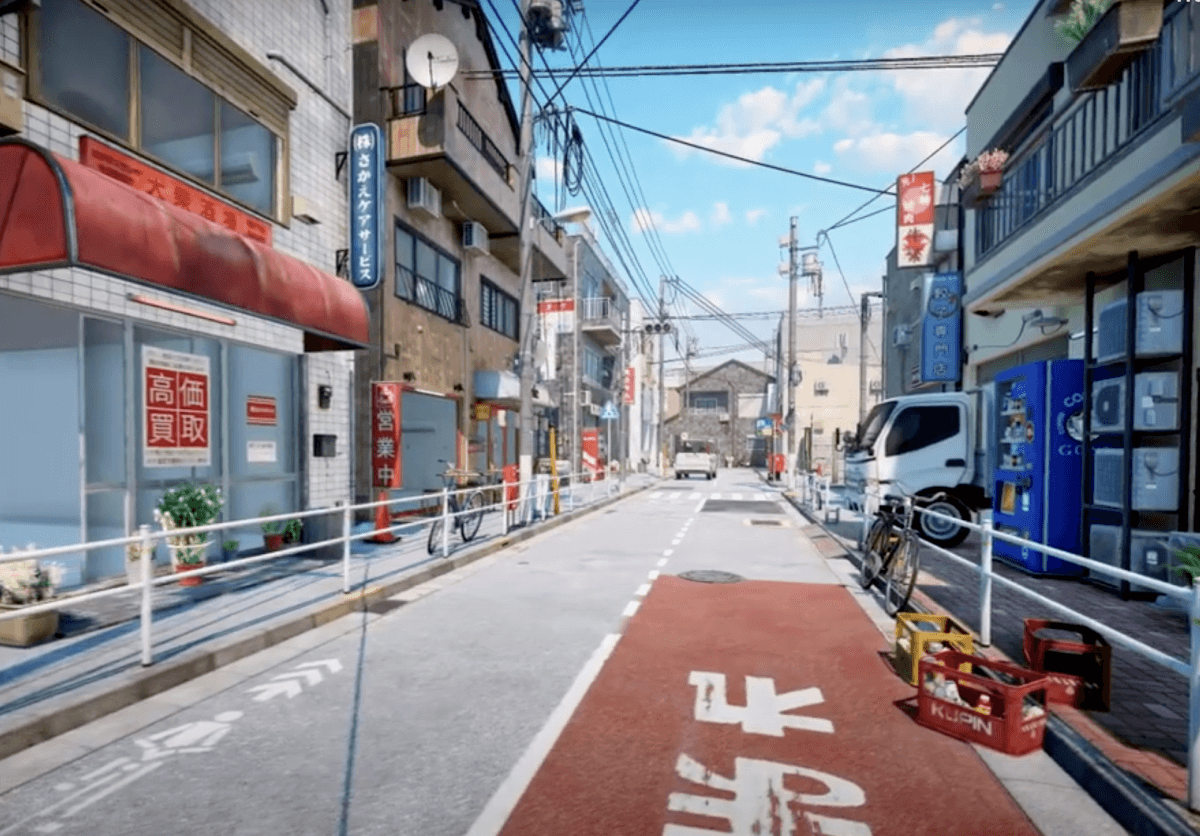


Interactions
Character Interactions
Engage with NPCs in task-based conversations, practicing language in specific scenarios.
Converse freely with main characters through AI, allowing for personalized, natural language practice.
Environment Interactions
Click on Japanese signs in cityscapes to access translations, connecting language with real-world context.
In stores or cafés, click on items to view vocabulary, linking words with everyday objects.
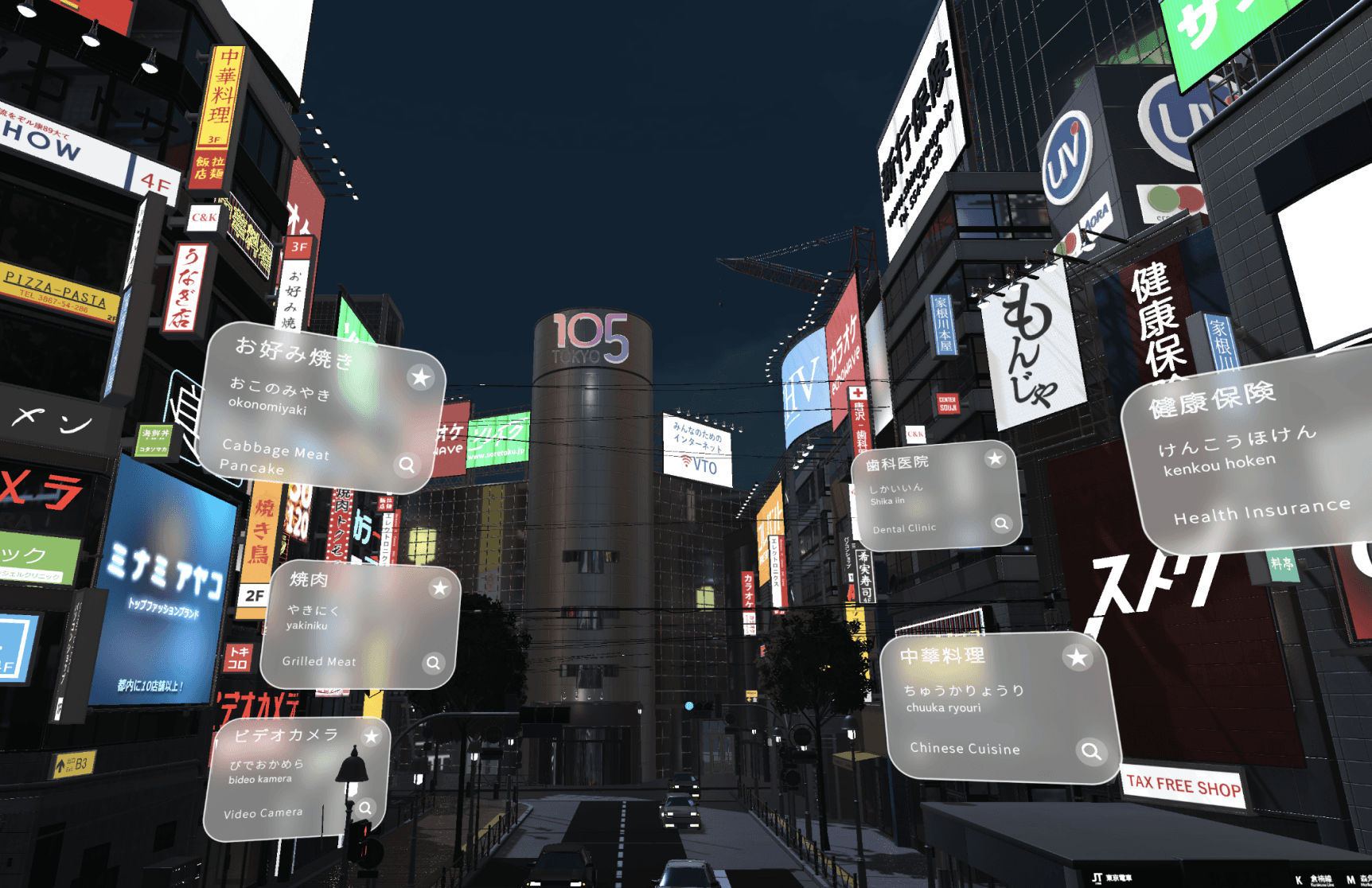
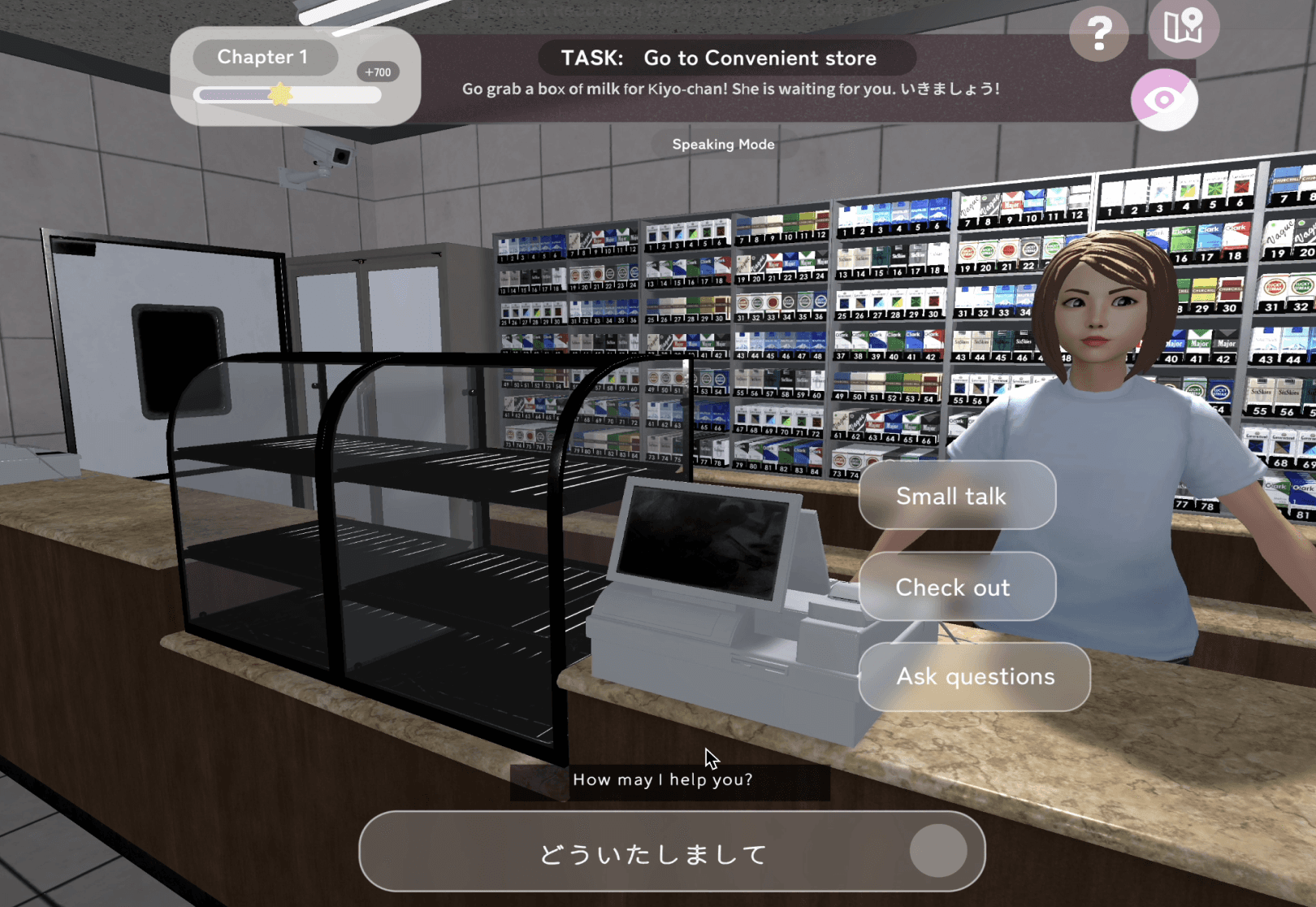
Interface User Flow

Interface & Mechanics
Life System
This system includes hunger, fatigue values, coins, and XP values, encouraging users to visit cafés, restaurants, or convenience stores to replenish "life points."
Users can earn coins and experience points through tasks, which can be used for working or unlocking more interactions.
💡 Guiding users to explore scenes, encouraging practical language use in realistic settings.
HUD System
The HUD displays current task progress, including help, map, chapters, and subtitle settings, allowing users to track their learning easily.
💡 Helping users transition between tasks smoothly, maintaining continuity in learning
Dictionary and Inventory System
The dictionary system allows users to click on objects or text in scenes to display vocabulary and translations, with an inventory for reviewing learned words.
💡 Associating vocabulary with real objects reinforces contextual memory, aiding vocabulary retention and accumulation.
Progress and Skill Analysis System
This system analyzes vocabulary, grammar, and abilities like listening, and speaking skills through quizzes and dialogues, providing feedback to support improvement.
💡 Helping users track progress and identify areas for growth, offering targeted insights for efficient learning.
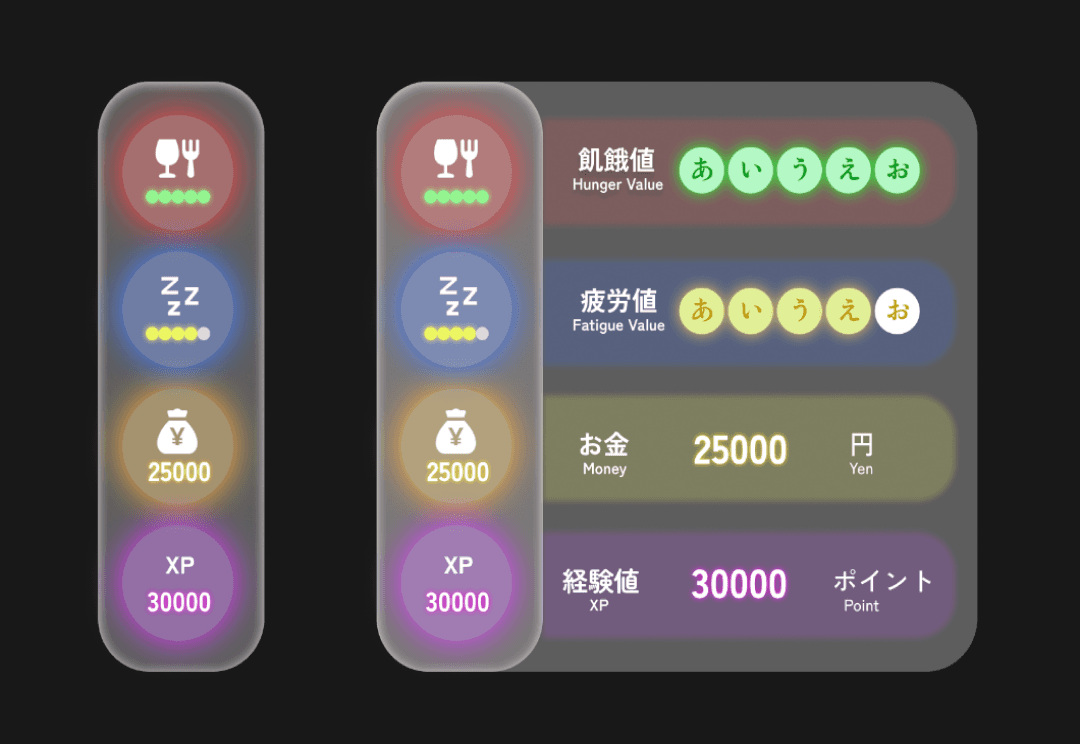



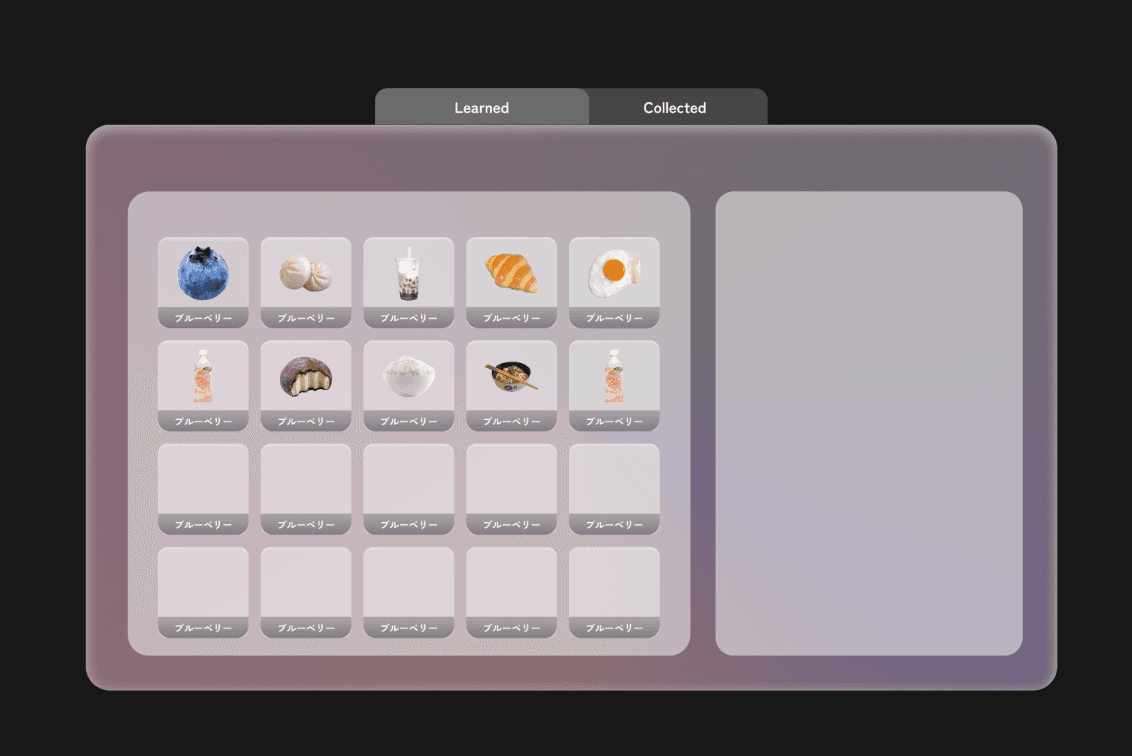
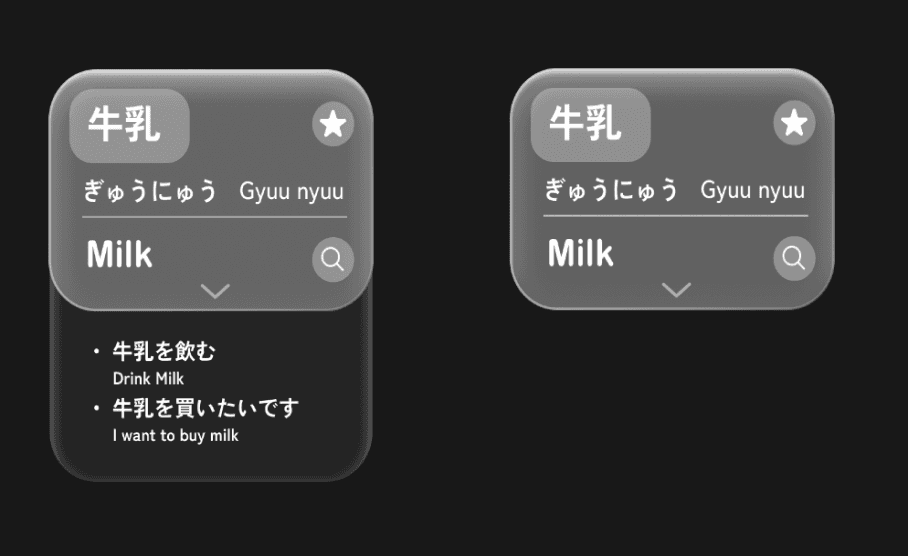
Subtitle Display System
Users can choose to display subtitles when needed, but each use costs coins, helping reduce dependency on translations.
💡 Encouraging users to interpret Japanese independently, enhancing their comprehension and inference skills.